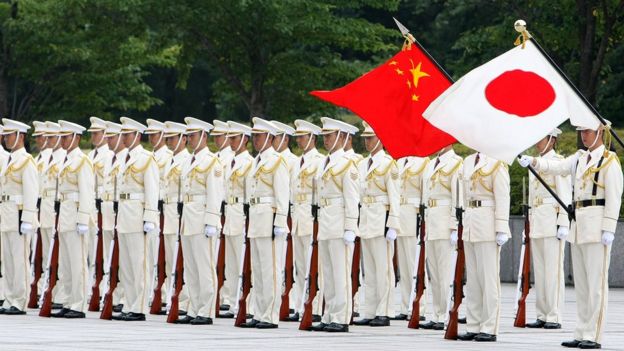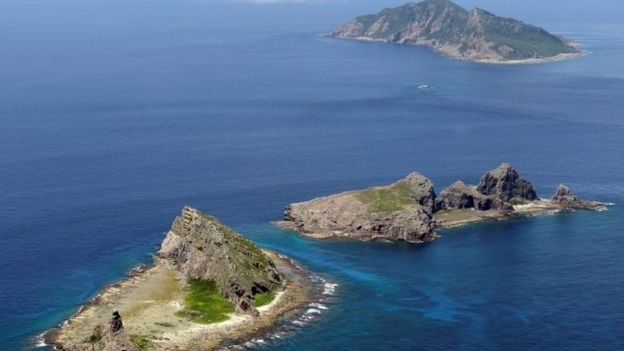Golez: Japan's own show of naval force in the South China Sea now underway with it's largest warship JS Izumo's exercises and port visits in the South China Sea:
"The pride of Japan's naval defence, the JS Izumo, is making an unprecedented journey through Asian waters over the next three months.
"Chinese critics of Japan's naval modernisation will point out that with a few minor adjustments, this ship could carry vertical take-off and landing fighter jets, including the F-35 stealth fighter.
"The Izumo is the largest vessel built by Japan since the end of World War Two - and she looks very much like an aircraft carrier. She has already participated in Singapore's first ever fleet review, an international naval gathering with fleets from Asia and beyond to demonstrate their power.
There is growing support in Japan for a more strident response to Chinese military assertiveness around Japanese waters and Japan's Maritime Self-Defense Force has been increasingly active in the region.
There is growing support in Japan for a more strident response to Chinese military assertiveness around Japanese waters and Japan's Maritime Self-Defense Force has been increasingly active in the region.
"It is all part of Japanese Prime Minister Shinzo Abe's determination to loosen constitutional strictures over the role of Japan's self-defence forces.
"The sea is where this is playing out right now.
"Japanese navy officials are careful to describe the ship as a "helicopter destroyer" capable of carrying more than 20 helicopters from its expansive flight deck, and thus playing down any offensive capabilities forbidden under Japan's constitution.
"Against the backdrop of China's narrative of suffering and humiliation at the hands of Japanese imperial forces during World War Two, the transit of the Izumo through the South China Sea is particularly sensitive for China, since Japan has been very vocal in its support of a ruling by the Permanent Court of Arbitration overwhelmingly against China's claims to a large expanse of the South China Sea and its features.
Japan's new military role
Japan's new military role
"The widening of Japanese naval operations in the South China Sea and beyond is also a response to a more pressing concern for Japan: China's own relentless drive to dominate the waters around Japan.
"Chinese critics of Japan's naval modernisation will point out that with a few minor adjustments, this ship could carry vertical take-off and landing fighter jets, including the F-35 stealth fighter.
"For China, therefore, the Izumo and the latest additions to the JMSDF fleet are both a symbol of a new era of military expansionism under Prime Minister Abe's administration and a painful reminder of China's wartime suffering and the destruction wrought by Japan's powerful carrier fleet of World War Two."
Japan's growing concern over China's naval might
 AFP
AFP
The pride of Japan's naval defence, the JS Izumo, is making an unprecedented journey through Asian waters over the next three months.
The Izumo is the largest vessel built by Japan since the end of World War Two - and she looks very much like an aircraft carrier. She has already participated in Singapore's first ever fleet review, an international naval gathering with fleets from Asia and beyond to demonstrate their power.
There is growing support in Japan for a more strident response to Chinese military assertiveness around Japanese waters and Japan's Maritime Self-Defense Force has been increasingly active in the region.
It is all part of Japanese Prime Minister Shinzo Abe's determination to loosen constitutional strictures over the role of Japan's self-defence forces.
The sea is where this is playing out right now.
 GETTY IMAGES
GETTY IMAGES
Japanese navy officials are careful to describe the ship as a "helicopter destroyer" capable of carrying more than 20 helicopters from its expansive flight deck, and thus playing down any offensive capabilities forbidden under Japan's constitution.
Against the backdrop of China's narrative of suffering and humiliation at the hands of Japanese imperial forces during World War Two, the transit of the Izumo through the South China Sea is particularly sensitive for China, since Japan has been very vocal in its support of a ruling by the Permanent Court of Arbitration overwhelmingly against China's claims to a large expanse of the South China Sea and its features.
Japan's new military role
The widening of Japanese naval operations in the South China Sea and beyond is also a response to a more pressing concern for Japan: China's own relentless drive to dominate the waters around Japan.
Chinese critics of Japan's naval modernisation will point out that with a few minor adjustments, this ship could carry vertical take-off and landing fighter jets, including the F-35 stealth fighter.
For China, therefore, the Izumo and the latest additions to the JMSDF fleet are both a symbol of a new era of military expansionism under Prime Minister Abe's administration and a painful reminder of China's wartime suffering and the destruction wrought by Japan's powerful carrier fleet of World War Two.
 AFP
AFP
For Japan's navy, however, impressive vessels such as the Izumo serve a dual purpose. They are both a symbol of the JMOD's desire to make a greater contribution to regional and international security and an example of Japan's contribution to its alliance with the United States.
This was shown recently when the Izumo escorted a US navy supply vessel in a joint manoeuvre not designated as a military exercise, under the auspices of a revised Article 9 of Japan's constitution, which outlaws war as a way to settle disputes.
Japan's defence industries, long fettered by Japan's pacifist constitution now feel emboldened to compete for defence contracts far from home.
Japan's new Kawasaki P-1 Maritime Patrol aircraft flew all the way to the Farnborough air show two years ago for a demonstration to the British MoD and last year, Mitsubishi Heavy Industries campaigned to supply a new generation of submarines for the Australian navy.
Territorial disputes over Senkaku
Japan's navy and coast guard in recent years have also been under increasing pressure to respond to China's campaign of incursions into Japan's territorial waters and frequent transits of vessels and aircraft through the numerous straits of the Japanese archipelago.
A focal point for such rivalry are the disputed Senkaku islands, known as Diaoyu in Chinese. Until 2012 when the Japanese government purchased the islands from their private owners, Chinese maritime law enforcement vessels seldom intruded into Japanese territorial waters.
Chinese outrage at the purchase triggered sustained incursions into Japanese waters at up to three incursions per month.
 AFP
AFP
Two years later the Japanese maritime agencies were alarmed to detect armaments on Chinese coast guard vessels and that Chinese navy frigates and destroyers were being transformed into white-hulled law enforcement vessels.
Recently such vessels have been increasing in size from 3 or 4,000 tonne to 10,000-tonne vessels.
While in 2012, Japanese and Chinese coast guard vessel numbers were roughly similar at 51 and 40 respectively, the Japanese government estimates that by 2019, the numbers will have swung hugely in favour of China at 135 vessels versus Japan's 65.
And there have been an increasing number of other concerning incidents for Japan in recent years.
Rising tensions
In June 2016 the Japanese destroyer Setogiri spotted a PLA Navy Jiangkai class frigate entering the contiguous zone around the Senkakus at the same time as a group of Russian navy vessels transited the same waters. That same month, Chinese naval intelligence-gathering ships entered Japan's territorial sea near Kuchinerabujima and Yakushima islands for the first time and in the southern waters of the Senkaku islands.
One particularly unnerving episode for Japan began in early August 2016 when a China coast guard vessel escorted 300 Chinese fishing vessels into waters around the Senkakus, and over four days a total of 15 coast guard ships repeatedly intruded into the waters, half of them armed.
The Japanese defence ministry suspects that many of the Chinese fishing vessels belonged to the maritime militia.
Meanwhile, the number of Japanese scrambles against Chinese aircraft around the East China Sea and towards the Senkakus has jumped dramatically, surpassing even the annual peak number of 994 during the Cold War.
 REUTERS
REUTERS
Japanese fighter patrols have also encountered challenging behaviour by Chinese PLA Air Force pilots in a similar vein to the increasing number of dangerous encounters between US and Chinese aircraft over the East and South China Seas.
The final element to China's saturation of the East China Sea is its unilateral construction of 12 new gas platforms adjacent to the Japan-China geographical equidistance line in an area agreed as a joint development zone between the countries. It is concerned that radars deployed by China on some of the platforms could be used in support of military operations.
China's strategic vision
For Mr Abe, the Izumo is a military instrument which could be deployed under his recent proposal to change Japan's constitution to allow a more assertive Japanese defence posture.
The deployment of Japan's naval assets further afield and more diversely alongside those of the US also helps to answer Donald Trump's calls for more burden-sharing within the alliance.
But most importantly, the Japanese government sees a direct link between China's behaviour in the South and East China Seas.
 REUTERS
REUTERS
The wider deployment and sustained presence of Japanese vessels throughout the region therefore underpins Shinzo Abe's consistent demands for China to abide by a "rules-based international order", which includes freedom of navigation through international waters.
However for China, the clamour for a rules-based order is simply camouflage for the perpetuation of a US regional hegemony and what the Chinese leadership describe as "outmoded Cold War thinking".
China has its own vision for regional security and a new geo-strategic plan accompanying it in the form of the the 'Belt and Road initiative', providing an alternative to US dominance in the region.
For China's new maritime Silk Road to succeed, it needs to secure its seas on its own terms but that means the potential for an unmanaged escalation between Japan and China increases substantially.
Alexander Neill is Shangri-La Dialogue Senior Fellow at IISS-Asia (International Institute for Strategic Studies - Asia) .The IISS Shangri-La Dialogue will be held in Singapore from 2-4 June.
No comments:
Post a Comment